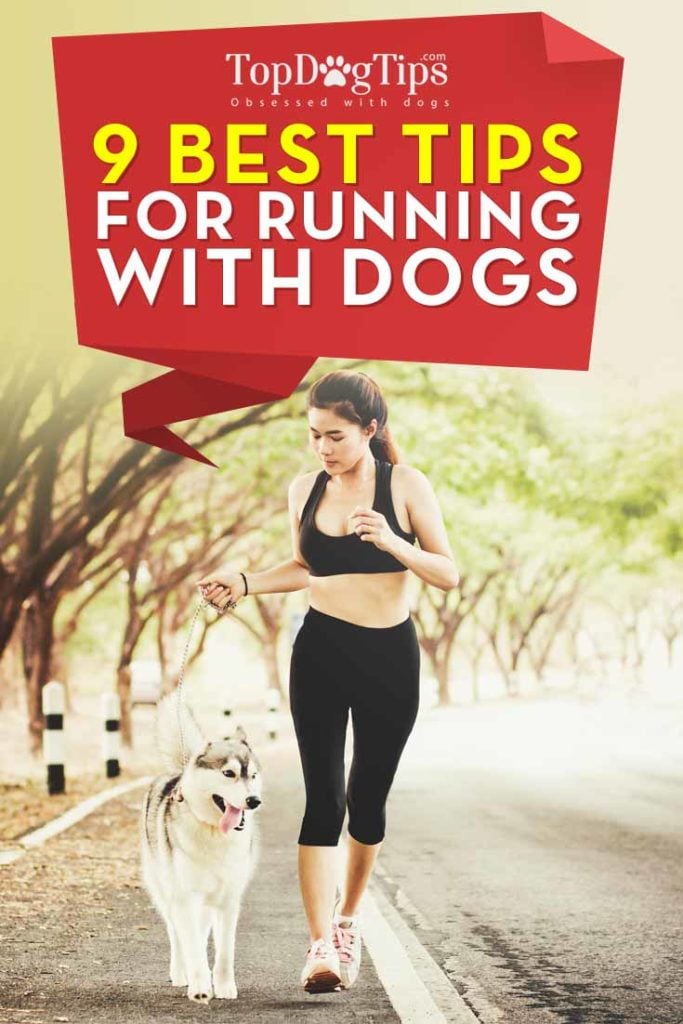
Table of Contents
Running can be a great pastime for dogs, not to mention that you and your dog get to spend time and bond together.
However, safely running with dogs is not always as simple as it seems. So here are some tips for running with dogs to keep you both safe.
Running with Dogs? Here are 9 Tips to Know!
1. Get Your Dog Checked Out First
The first and one of the most important tips for running with dogs will need to be done before you even think about taking your pet out for exercise.
Before your dog starts running with you, it would be a great idea if you took her to the vet for a check-up just to make sure there are no issues that may cause problems.
Your vet will be able to thoroughly examine your dog to make sure there are no existing conditions that may be made worse by running.
It’s so important that you do this because certain conditions can flare up when too much physical activity is carried out.
2. How Old Is Your Dog?
If you have a puppy at home then you definitely shouldn’t plan on running or trying other sports with her until she stops growing.
Wait until your puppy is one or two years old before you start running with her.
Older dogs probably aren’t the best pets to go running with, either.
They need to take things a bit easier than younger dogs, and running should be avoided.
Older dogs can suffer from inflammation, just like we do when we get older. Running is probably the last thing on their minds, as it can be painful.
It doesn’t mean that your dog cannot exercise at all, and your vet will advise you on whether or not a middle-aged dog or, indeed, an older dog should go running.
Walking may be a better option, but indeed there are some senior pets that are still in shape to run with their owner.
3. Consider Your Dog's Breed
There are some breeds of dogs that absolutely love running; they were just born to run. However, there are many breeds out there that are considered lazy couch potatoes and not only do they not enjoy running, some of them even shouldn't spend too much time jogging.
They are not born athletes and are happier with just a short walk. The best tip for running with dogs is to adopt a breed that enjoys the hobby.
Boxers make great runners, along with Border Collies, Weimaraners, German Poiters, and some Terriers.
If you have any of these breeds, including Bassets, Poodles, Dachshunds, or Shih- Tzus then be very careful.
They are long-backed and short-legged dogs that can suffer from back problems. Your vet will advise on whether or not you should run with any of these breeds, but it's likely that you should not.
Most dogs can easily be trained to run between two and three miles a day, but remember to consult with your vet first, as it’s better to be safe than sorry.
4. Let the Dog Warm Up First
Just like we need to warm up before exercise, our dogs do, too. Make sure you prepare your dog’s body so that she's ready for physical activity.
This way, she is far less likely to suffer from any injuries, and it only takes a few minutes to do.
Start by stretching your dog’s muscles and joints. Go for a short 10 minute walk before you head off on your run, this really is all it takes to get your dog warmed up.
Dogs also need to do strength training. Try going for walks with your dog in the sand, which is quite deep, or for a slow hike. These activities will help to strengthen your pet's muscles.
5. Help Them Build Endurance
One of the most important tips for running with dogs is not to start out too quickly. Your dog has to be fit before she can go running with you.
It’s no good just going off on the run and thinking your dog can run 7 miles with you. She absolutely will not be able to keep up without proper conditioning.
Your dog needs to be physically ready and strong enough to go the distance, just as we need to be.
If at any time you feel as though your dog cannot keep up with you, stop the run and take her home.
Dogs aren’t born fit; you have to work at it. Their bodies need to adjust to physical activity, just like us.
Try running with your dog for short distances at first, go for 15 minutes during week one and then gradually keep on increasing the distance each week until you know your dog can make the full distance you want to run each day.
6. The Run Itself
Your dog can’t let you know when she's feeling exhausted tired, or even in pain.
You have to be the judge as to how she is doing. Your dog will do all she can to please you and will keep on going even if she is struggling. If at any time during the run, you think your dog is in distress, end the run and take her home for a rest and some water.
As you’re running with your dog, keep on looking at her face, breathing, tail position, and also her gait. The pace of your dog is the key to how she is doing.
She should be running next to you or in front of you. Your dog definitely shouldn’t be behind you, struggling to keep up.
If you notice she is struggling behind, then that’s a good indication that your dog just cannot keep up anymore. Your dog's tail can actually help you monitor her.
The dog’s tail position and breathing should be the same as they were at the beginning of the run.
If you notice her tail has dropped or she is breathing louder, this means that she is working too hard.
Heavy panting means that her heart rate is way too high, and if your dog starts to foam at the mouth, you should end the run immediately and give her some water.
Keep looking at your dog’s gait, as this will be a good indicator of how she is doing.
Look out for weakness, fatigue, and any injuries. Most dogs, when really enjoying a run, will trot, canter, or gallop, just like a horse, but a dog in distress will run with a gait that shows pain.
Keeping an eye on your dog at all times while exercising is one of the tips for running with dogs that could end up saving your pet's life.
7. Watch Your Dog’s Paws in Different Weather Conditions
Always look at your dog’s paws before and after a run. Hot weather can play havoc with your dog’s paws, as the ground they are running on could be very hot to touch (especially if you're running on asphalt).
Always test the ground surface with your hand before you set off on a run with your dog to see if it's too hot, for example.
Cold weather can also cause problems as the ground can get frozen.
This could cause your dog to develop frostbite. If the weather is very humid, you need to keep an especially close watch on your dog because dogs don’t have sweat glands. Never let your dog become too hot on a humid day.
8. Look Out for Soreness
Our dogs can get injured, just like us, so it’s important that you keep a check on your dog for any signs of aches and pains.
You may think that all tips for running with dogs will be used before or during the run, but dogs don’t always show signs of distress until the day after running.
Watch out for signs that may include a lack of energy, soreness, lethargy, or just very tired.
A dog that’s doing fine will be unfazed and will be ready for another run.
A dog that’s in distress, however, will be less enthusiastic to go for a run again. Dogs can develop ligament and back issues caused by tears when out running.
Watch out for signs that could include leaning to one side or limping.
Your dog’s behavior can also be a clue. Any change in your dog’s behavior could indicate a problem.
A dog who doesn’t want to move around much is likely to be a dog that’s in pain.
9. Provide Good Nutritional Food
Providing proper nutrition is essential, especially if your pup is an athlete. Your pet will need good-quality nutrition if she is a regular runner.
Protein is the key ingredient. If your dog is your running partner, then she will need more protein and also more antioxidants in her diet.
You can also try feeding your dog raw food that could include sweet potatoes and cooked broccoli mixed with chicken or fish. Don’t take your dog for a run for at least an hour after she has had her meal.
Be sure to discuss a change in diet with your veterinarian first.
You need to be sure that whatever diet you're feeding your dog meets her individual nutritional needs.
Of course, proper hydration makes our list of the most important tips for running with dogs.
It’s important to remember that you should never let your dog drink a whole bowl of water in one go, as this could cause bloat, which is a serious medical emergency.
When you’re running, provide your dog with water every 20 minutes to keep her hydrated and cool. Dogs need just as much water as we do.
READ NEXT: The Dos and Don’ts of Running with Dogs
Want to share this?













